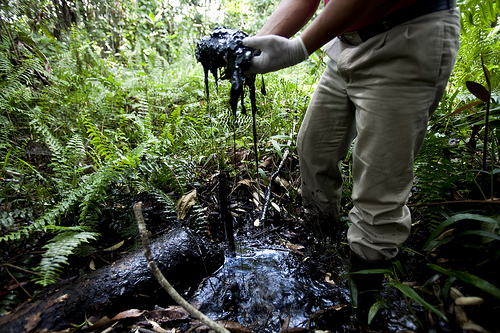
When a green heaven turns into black waters (Oil pollution in the Amazon rainforest)
25 November, 2010A deep, lush and luxuriant vegetation, winding rivers, an incredible wildlife, ancestral civilizations with their shamans and their extraordinary myths, and… oil fields. The legendary Amazon rainforest embodies what the planet has best to offer in terms of biodiversity and traditional cultures. But, today, it is threatened by oil pollution and deforestation. The Oriente, the Ecuadorian jungle, – which covers about half the territory, including national reserves with the most unique and richest biodiversity in the world – has been highly exploited by oil companies for decades, irreversibly damaging its environment and communities. Texaco, bought by Chevron in 2001, is blamed to be responsible for contaminating the rainforest during twenty-eight years and has to face a historic lawsuit that started in 1993.
 With about seven million square kilometers, the Amazon rainforest, the largest rainforest in the world, is said to be the lungs of the planet and holds an essential role in the health of the Earth. It harbors a tremendous amount of species of fauna and flora, more than anywhere else. According to a WWF report released in October 2010, 1,200 new species had been discovered in the Amazon rainforest between 1999 and 2009, that is to say one every three days. In Ecuador, the 100,000 square kilometer jungle is the home of tens of thousands of plants, including those for medicinal use, and animals. It is also inhabited by indigenous civilizations such as the Cofán, Siona, Secoya, Kichwa and Huaorani who perpetuate their traditions, away from our modern lifestyle, and live in perfect harmony with nature, from fishing and hunting.
With about seven million square kilometers, the Amazon rainforest, the largest rainforest in the world, is said to be the lungs of the planet and holds an essential role in the health of the Earth. It harbors a tremendous amount of species of fauna and flora, more than anywhere else. According to a WWF report released in October 2010, 1,200 new species had been discovered in the Amazon rainforest between 1999 and 2009, that is to say one every three days. In Ecuador, the 100,000 square kilometer jungle is the home of tens of thousands of plants, including those for medicinal use, and animals. It is also inhabited by indigenous civilizations such as the Cofán, Siona, Secoya, Kichwa and Huaorani who perpetuate their traditions, away from our modern lifestyle, and live in perfect harmony with nature, from fishing and hunting.
But this peaceful environment has been destroyed for decades by oil drilling activities. In 1964, Texaco Petroleum Company (Texpet), a Texaco subsidiary, now Chevron, one of the major oil companies, was invited by the Ecuadorian government to introduce its technology and drill for oil in the Northern part of the Oriente. Oil workers settled in the Sucumbios province, in the town of Nueva Loja they called Lago Agrio, named after Texaco’s birthplace Sour Lake, Texas. That year, a consortium was signed between Texaco, Gulf Ecuatoriana de Petróleos S.A. and the Ecuadorian government, to explore and drill oil in the area until 1992. In 1967, a major oil discovery was made and a 523-kilometer Trans-Ecuadorian pipeline, SOTE (Sistema Oleoducto Transequatoriano), with a daily transport capacity of 250.000 barrels was built in 1972, followed by the creation of a state oil company, CEPE (Corporacion Estatal Petrolera). The consortium was re-examined and the Gulf company pulled out of Ecuador, leaving Texaco, in partnership with the government company, as the exclusive operator of oil extraction in the area. In 1989, the CEDE became Petroecuador, who took over the operations until the end of the consortium in 1992. During the consortium period, Texaco carved out about 350 oils wells to extract some 1,500 million of barrels of crude oil.
One year after the end of the concession, in 1993, a historic lawsuit, the case Aguinda v. ChevronTexaco, was filed by 30,000 rainforests residents against Texaco before New York federal court. The plaintiffs were alleging massive oil contamination of the rainforest resulting in environmental and health damages. It was one of the first environmental trials to be conducted in the U.S. by foreign plaintiffs arguing that an American company had broken the international regulations by contaminating a foreign country. But in 2003, under Chevron’s request, the suit was transferred to Ecuador.
In this war against the giant oil company, the plaintiffs, supported by many NGOs such as Amazon Defense Coalition and Acción Ecológica, accuse Texaco of dumping more than 18 billion gallons of toxic and highly saline waters called “formation waters,” a byproduct of the drilling process, into the rivers and soil, a practice that was outlawed in the U.S. at that time. About 4 million gallons of saline water were being discharged daily. It is estimated that, thanks to this method, Texaco saved nearly $3 per barrel of oil produced. Moreover, over 16 million of gallons of crude oil were spilled from the pipeline into the forest. The company also abandoned some 1,000 open-air toxic pits. As a whole, the amount of crude oil spilled or dumped into the Oriente accounts for about 1.5 times the amount discharged during the Exxon Valdez disaster. The company also burned or vented millions of cubic meters of natural gas into the atmosphere without any adequate control. To penetrate into the dense rainforest and build more than 480 kilometers of roads, Texpet had to deforest more than a million hectares.

In 1995, while the scandal was spreading around the world, Texaco tried to remediate the conflict by settling a Cleanup Agreement with the Ecuadorian government. It initiated a 40-million-dollar clean up which was completed in 1998. In that year, the Ecuadorian government certified the remediation was achieved and released Texaco from future liabilities.
This “Rainforest Chernobyl”, as it was called, has had catastrophic environmental, health and cultural consequences. Studies have shown an excess number of cancer, leukemia and pregnancy miscarriage cases among the people exposed to oil contamination in the region, including at least 1,401 casualties from cancer. The incidence of cancer in the affected areas is estimated to be up to 31% against 12.3% nationally. The indigenous population also suffer from lack of drinkable water and natural resources to survive due to the pollution of waters and soil. As a result, they have been obliged to change their lifestyles and traditions. So far, two tribes, the Tetetes and the Sansahuaris, have died out.
According to a study submitted by the affected communities, in accordance to a Court’s Order in August 2010, the environmental catastrophe could put nearly 10,000 people at risk of dying from cancer by 2080 even if Chevron achieves a proper cleanup in the next ten years. This figure could significantly increase if nothing is done. This report prepared by environmental, economic and medical consultants also estimates that the damages will cost over $113 billion, much more than the estimation of a previous report made in 2008 by court-appointed expert Richard Cabrera, which assessed the cost would reach up to $27.3 billion. This evaluation includes soil, groundwater, river and wetland remediation, health care, installation of drinking water, natural resources loss, cultural impact, as well as Chevron’s unjust enrichment. Besides, to the plaintiffs, the cleanup agreement was fraudulent because it had been misconducted. They argue that the pits were just covered with earth or superficially cleaned instead of a real remediation. As a proof, oil can still be found in the contaminated areas.
As a defense, Chevron argues that “produced water is not considered “toxic waste” in the United States nor in any other part of the world”. According to them, a separation process was used to remove the oil from the saline water and treated before discharging it into the streams. Moreover, the comparison with the Exxon Valdez disaster is “nothing more than lies” because they did not spill crude oil but discharged water, the equivalent of 1.7% of the total volume of the water dumped onshore in the United States in 1985. Much scientific evidence presented to the Court show that more than 99% of all drinking water samples tested were “free of harmful levels of petroleum related chemicals, exceeding World Health Organization and USEPA standards” and more than 99 % of soil samples from Texpet-cleaned areas proved that the remediation was effective. They claim that there is “no significant oil-related health risk from the areas remediated by TexPet”. The health problems of the area are to be attributed to other factors including inadequate sanitation and sewage systems, water contaminated from biological sources and pesticides, chronic malnutrition or poor medical facilities. They also say, that Petroecuador, as a majority partner, had a significant control over the operations and participated in all major decisions regarding equipment, technology and production methods. Besides, the state company is responsible for the current operations in the Oriente and is to be blamed for a total of 801 spills between 1990 and 2004, with a total spill volume of 1.9 million gallons. And, in this way, Texaco can refute all the allegations made by the plaintiffs.

The heavy battle between the Ecuadorian rainforest inhabitants and Chevron began seventeen years ago and is still not settled. Who knows how long it will last before justice will be dealt out. But it is undoubtedly an historic lawsuit that will pave the way to other similar cases. From now on, the world will pay more attention to the communities affected by environmental contaminations.
All images from Rainforest Action Network except picture of monkey by Mary-Fleur Tordjmann
Follow Sounds and Colours: Facebook / Twitter / Instagram / Mixcloud / Soundcloud / Bandcamp
Subscribe to the Sounds and Colours Newsletter for regular updates, news and competitions bringing the best of Latin American culture direct to your Inbox.

